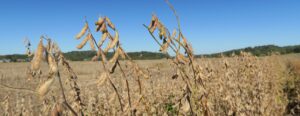Early Burndown. The challenge to burning down grasses before planting has become increasingly difficult in the last half dozen years. There are two reasons for the sketchy grass control with the traditional burndown application of glyphosate + dicamba. First, the continued evolution of glyphosate resistance in ryegrass, junglerice, johnsongrass and goosegrass have made that “go-to” burndown application inconsistent. Second, we have now documented that dicamba is consistently causing glyphosate to provide poor grass control. As such our recommendation has been to change the “go-to” burndown from glyphosate + dicamba to glyphosate + clethodim.
The problem with using glyphosate + clethodim is that the burndown will miss, or be weak on, some broadleaf weeds, most notably glyphosate-resistant horseweed. During the meeting circuit this winter, several have asked “Is there a herbicide that can be added to glyphosate + clethodim that will provide horseweed control while not sacrificing grass control?” This caused me to go back and examine burndown research we conducted 4 and 5 years ago with Elevore and Verdict. Continue reading



